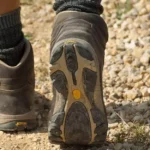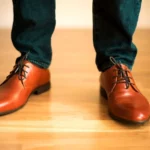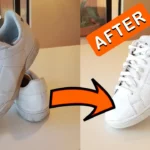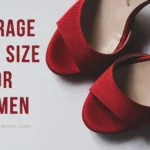We’re all acquainted with the agony of shoes rubbing the back of our heels, regardless of whether it’s caused by our feet expanding as a result of heat or not breaking in a couple of new shoes. It tends to be very awkward, agonizing, and troublesome, to say the least.
How to protect your heel (Back of Your Ankle) from Rubbing? Shoes rubbing against your heels can, and generally is painful, as we all know. So what do you do to protect your heels? You have to reduce the friction between the inside of your shoes and your heels. Let’s discuss how you can do that.
The thing is, breaking in shoes can be pretty tiresome and can take a long while, and that is scary news for our heels, especially if we don’t know how to break in our new shoes without hurting our heels. Also, there is maybe nothing worse than feeling the inside of your shoes rubbing against your heel, and knowing that if you don’t take them off, they’ll hurt you big time and give you nasty blisters. But if we don’t wear them, it would be a waste of money, right? So, just how to stop shoes from rubbing the back of your ankle?
How to Break in Shoes that Rub Your Heels
All the methods we will be showing you on how to break in shoes that rub your heels are divided into two classifications as listed below;
- Protect your heel from rubbing.
- Work on your shoe to stop it from rubbing the back of your Ankle.
Method One: Find the Blister Spots on Your Legs and Use Band-Aids
Blisters are formed as a result of excessive friction between your heels and the inside of your shoe. Its sort of a fight that your heels will never win, so we suggest you stop the fight before it even starts. To do this, make sure you identify the likely areas of friction and cover those areas with a bandage.
This is the only way to avoid pain, so we suggest you take it. If you don’t know your usual blister spots, you can wear your new shoes for about 20 minutes, and you’ll find them immediately.
Wearing protection Band-Aids will assist you with breaking in your shoes faster in light of the fact that you’ll have the option to wear them longer. We propose wearing fabric Band-Aids since they’re a lot sturdier than the plastic ones that easily peel off as a result of moisture building up on your leg.
Method 2: Use Deodorants on Your Blister Spots, a lot of it
Deodorants help to prevent perspiration, and in the fight to make sure you don’t have blisters, winning the battle against perspiration is one of your key battles. It is advisable to slather your heel and any other blister spots on your legs with deodorants.
The more, the better. You can also repeat this method at work, so don’t forget to take your deodorant stick with you when leaving home. It would save you a lot of pain and a couple of blisters.
Method 3: Use Moleskin
Another great way to break in a shoe that hurts your heels is to use moleskin. Moleskin is a thin but heavy cotton material that is very durable, and hence can be used to prevent blisters. Remember we are all about preventing blisters before they form, so identify the likely areas of friction, and hence blisters, and make sure to clean them.
Moleskin generally is better than bandages, because unlike bandages, it doesn’t come off easily. Also, it is thicker, which allows it to cushion the effect of the inside of your shoes rubbing on your heels a lot better and help you prevent blisters.
If you don’t like wearing bandages or moleskin, then you can also apply the adhesive side of the moleskin to the inside of your shoes so it becomes easy to break the shoe in, as your heel would always come in contact with the soft moleskin and not the hard material of your new shoes. This way, you can stop the shoe from rubbing the back of your heel, and at the same time breaking in the shoes. See, 2 for 1 deal.
Method 4: To Break in Shoes that Rub Your Heel, You Can Also Apply Vaseline
The Vaseline would act as a lubricant and prevent friction from occurring between your heels and the inside of your shoe, especially those shoes that rub against the back of your heel and hurt you.
Just like the deodorant stick method, you can take your Vaseline along with you to work, so even if you feel the slightest bit of friction because the one you applied at home is finished, you can simply reapply and stop the shoes from rubbing the back of your heel.
Work on Your Shoe to Stop it from Rubbing Your Heels
If you don’t want to do anything to your feet but feel the shoe that rubs the back of your heel should be worked on, then this section is for you. We will be discussing how to make that work.
Method 1: To Stop Shoes Rubbing the Back of Your Heel, Add Some Heat
Heat makes things expand, and with the inside of shoes that rub your heel, this could be a good thing. You see, that shoe that’s terrorising your heels and rubbing it, causing you to be uncomfortable, it is no match for heat.
All you have to do is apply some heat and the shoe will become less hard. It will also mold to the size of your feet, making it seem like a second skin. Do you like it? We do, too.
To use this method, wear a thick pair of socks or two, put on your shoes, and put on a dryer. Set the heat on medium, and blast away. Aim for the back of your shoes, but don’t stay there too long. Do this for about two minutes, and then stop.
The material of the shoes should have expanded, so keep it on whilst it cools and molds to the shape of your feet. This way, your shoes would stop rubbing the back of your heel and become comfortable to wear.
Precaution: make sure the material of your shoes is genuine, especially in the case of leather, or the heat could melt away the plastic.
Method 2: For Shoes that Rub Your Heels, Bend and Twist them
The materials of your shoes are tough and they rub your heels because they go through several treatments, which ends up making them rigid. This is especially true for real leather. So if you have genuine leather shoes that rub your heel, just pick up your shoes and twist.
The shoes may be hard but think of the time they have rubbed your heels and twist them. Especially the heel areas. Do this after you have just worn them, so they’ll still be warm and the material would still be more flexible.
Twisting and bending them this way would help to break in easier, and in time the material would relax and stretch. Just don’t twist too hard so the material wouldn’t be damaged.
Method 3: Use a Spoon to Stop Shoes Rubbing the Back of Your Heel
Sounds funny? It is, but it works. Turns out you can use a spoon to mimic the motion of walking and helps to soften the shoe. Granted, it’s not an orthodox method, and you may not have heard of it before, but it works, especially when the shoe is really tight and hurts a lot as it rubs the back of your heels.
All you have to do is to rub the back of your spoon against the inside of your shoe on the heel side. Simple. Apply some pressure, especially if the heel area of your shoe is very hard, but make sure you don’t scratch or damage your shoes with the edge of the spoon. This mimics walking motion and helps to break in your shoe, so you can wear it and be comfortable.
Method 4: Use a Shoe Stretcher for Shoes that Rub Your Heels
If you happen to be in a situation where you’re breaking in a number of shoes, perhaps it would be wiser and less stressful to use a shoe stretcher. They save you time and help you work on the heel side of your shoes, on the inside.
You can leave a shoe stretcher in your shoe for about 8-10 hours and wear it to see if the heel area on the inside still hurts. If it does, leave the shoe stretcher inside the shoe for a while longer, moving it around in it till you achieve the level of stretch you require for your shoe, so you can wear it and not have it rubbing against the back of your heel.
Will these Methods Really Help to Stop Shoes Rubbing the Back of My Heel?
You bet. Shoes rubbing against your heels can be a nightmare. But it doesn’t have to be that bad, not to mention painful. The methods we’ve explained above should make it easier to break in shoes that rub your heel, allowing you to wear your shoes with the utmost comfort and giving you an overall boost in confidence as you go through your day.
Related Post:-
- How to Stop Shoes Slipping at Heel
- How to Fix the Heel of a Boot
- Best Wide Running Shoes with Wide Toe Box and Narrow Heel




